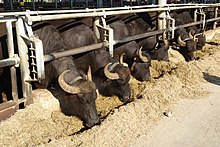The Italian Mediterranean buffalo or bufala mediterranea italiana is an Italian breed of water buffalo.[3] It is of the River sub-type of water buffalo and is similar to the buffalo breeds of Hungary, Romania and the Balkan countries. It is the only indigenous water buffalo breed in Italy.[4]: 94 A herd-book was opened in 1980, and the breed was officially recognised in 2000.
 | |
| Conservation status | |
|---|---|
| Other names | Bufala mediterranea italiana |
| Country of origin | Italy |
| Distribution | Throughout Italy, principally Campania |
| Type | River |
| Use | Dairy, meat; formerly draught |
| Traits | |
| Weight |
|
| Height |
|
| Skin colour | Dark slate-grey |
| Coat | Black |
| |
History


There are conflicting hypotheses concerning the origins of the European water buffalo: one, based on fossil bones found in the valleys of the Elbe and the Rhine, is that it descends from the extinct European wild species Bubalus murrensis; others believe that water buffalo were brought to Europe in the sixth and seventh centuries by invading peoples such as the Pannonian Avars, or later, by crusaders returning from Mesopotamia.[5]: 967 Detailed studies of the DNA of European buffalo have not been made.[5]: 967
The buffalo may have been introduced into Italy in Roman times, or during the Barbarian invasions of the Italian peninsula.[4]: 94
In 1979 a national association of buffalo breeders, the Associazione Nazionale Allevatori Specie Bufalina, was formed, and a genealogical herd-book for the buffalo was opened in the following year.[4]: 94 The mediterranea italiana breed was officially recognised in 2000.[6]
In 1953 the total number of buffalo in Italy was estimated at 40,000 head.[4]: 94 The numbers of buffalo reported by the Istituto Nazionale di Statistica in 2012[7] and 2013[8] were, by region:
| Region | 2012 | 2013 |
|---|---|---|
| Basilicata | 626 | 430 |
| Calabria | 778 | 271 |
| Campania | 260153 | 266236 |
| Emilia–Romagna | 158 | 409 |
| Friuli–Venezia Giulia | 80 | 39 |
| Lazio | 66546 | 69244 |
| Lombardy | 3394 | 3542 |
| Marche | – | 49709 |
| Molise | 1912 | 745 |
| Piedmont | 795 | 49 |
| Puglia | 7470 | 5999 |
| Sardinia | 5139 | 2507 |
| Sicily | 768 | 2454 |
| Trentino–Alto Adige | 8 | – |
| Tuscany | 110 | 48 |
| Umbria | 29 | 20 |
| Veneto | 895 | 957 |
| Total | 348861 | 402659 |
Characteristics
The mediterranea italiana is black, with dark slate-grey skin and black hooves. White markings may be present on the head, on the lower legs or on the switch of the tail.[4]: 95 Total albinism may occur, but is much less common than in the buffaloes of Asia, where the incidence of albinism is in the range 5–8%.[4]: 95
Bulls commonly stand about 143 cm (56 in) at the withers, with a weight of some 500–600 kg (1,100–1,300 lb); they may reach weights of up to 800 kg. Sexual dimorphism is less marked in domestic buffalo than in cattle; cows stand about 138 cm (54 in), with weights in the range 300–450 kg (660–990 lb).[4]: 95
Use

In the past the buffalo was widely used as a draught animal. Buffalo also kept waterways and drainage channels clear of weed, swimming in the deeper parts and wading in the shallows.[9]
The mediterranea italiana is now raised and selectively bred principally for the production of the buffalo milk used to make buffalo mozzarella, notably the Mozzarella di Bufala Campana of Campania, which has Denominazione di origine protetta (DOP) status.[4]: 95 Other dairy products including burrata, caciotta di bufala, ricotta di bufala, scamorza di bufala, stracchino di bufala, stracciatella di bufala and yoghurt are also made from the milk. Lactation lasts on average 277 days, and usually yields 1,600–1,800 kg (3,500–4,000 lb) of milk; yields of 2,000–3,000 kg (4,400–6,600 lb) per lactation are not uncommon.[4]: 95 In 2012 a total of 192,455,300 kg (424,291,300 lb) of buffalo milk was produced in Italy, about 1.7% of total milk production in that year;[10] the fat content was an average of 7.92%.[11]
Some are butchered, either for fresh meat or for preserved meat products such as bresaola di bufalo.[4]: 95 In 2012 a total of 118,653 buffalo were slaughtered in Italy, for a total live weight of 47,416,700 kg (104,535,900 lb), approximately 2.7% of the total weight of bovines slaughtered that year. The average carcass yield was 50.6%.[12]
References
Further reading

- Antonio Borghese (2005). Buffalo Production and Research. REU Technical Series 67. Rome: Food and Agriculture Organization of the United Nations.